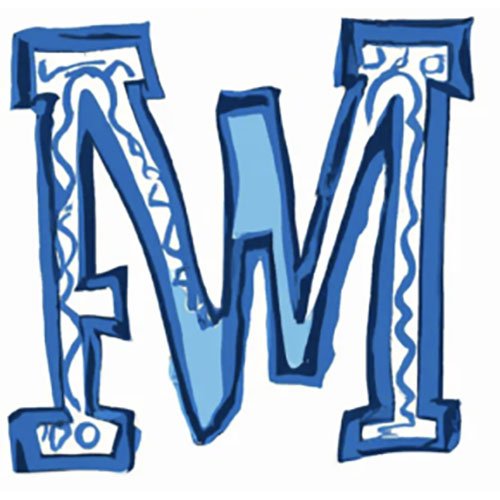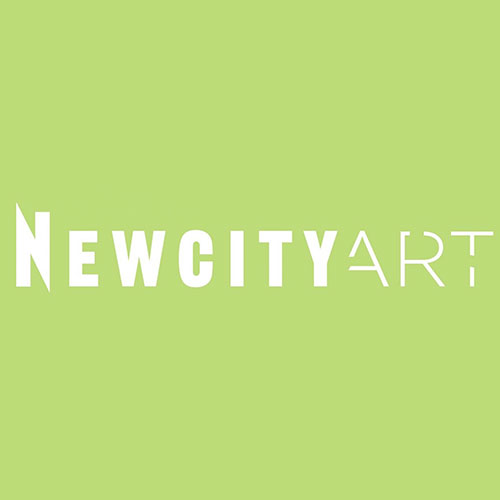I was already discombobulated when I arrived at Under the Cherry Moon, Povos Gallery’s exhibit of new work by Ashkon Haidari. My broken glasses were taped in the middle – Revenge of the Nerds style – and my head was pounding after I whacked myself opening the gallery’s (heavy!) bathroom door. Little did I know Haidari had a final injury waiting for me, this one to my pride: any way I found into his paintings seemed inconsequential.
Haidari’s career began with cartoonish cubo-futurist mock-battles. No matter how hard I look at them, I can’t grasp what’s going on. His figures were in equal measure spiky and bulbous, in both ways grotesque. His lines were promiscuous, serving anywhere from two to four separate figures at a time. Various pictorial centers emerge and quickly collapse. Ordinary faces peek out before revealing their hideousness. Haidari’s early work never congeals into an arrangement of figures, or shapes, or colors, or lines, existing only as an implosion of pictorial structure (something like Albert Oehlen without the self-seriousness).
Haidari’s later works (including those at Povos) have shifted his obfuscation from a pictorial angst to something further down the line: allegory. His recent large-scale works tempt viewers with so many lush symbols: vases turned upside down, shadowy O’Keefe-esque mountains, and giant gaudy blue lollipops, to name a few. These paintings beg to be interpreted the easy way, for their component parts to designate only one thing outside of themselves, and for the picture to neatly align with some real-world “deeper meaning.”
But in the same way that Haidari’s early drawings disavow any perceived pictorial order, no one-to-one allegory reveals itself. Haidari’s paintings take iconography from Islamic geometric patterns, Holbein’s portraits of the bourgeoisie, Dali’s psychosexual symbolism, and the cubist zeitgeist, among other things. It’s bewildering. There’s just too much to account for. Yet, the confusion these paintings inspire is infinitely more interesting than any clear-cut deeper meaning that could be ascribed to them. (Thomas Nast’s political cartoons fit the narrow interpretations that Haidari’s canvases avoid: “Oh, this nasty guy is the Catholics, this hideous one is Tweed, and this handsome good-intentioned one is the American people!” I’ll bet few have ever looked at one and said “Damn, that’s beautiful.”)
Thief in the Fish Market is chaos incarnate, both in its subject matter (a muscular figure on roller skates clutches a giant fish while paintbrushes and katanas fly through the air) and in its disparate sources of inspiration (Japanese architecture, the hue of Picasso’s Guernica, the slant of light in The Calling of Saint Matthew, the ungainly figure of animated kids’ movie villains). Inexplicably, everything just works. Minutes pass as my eyes dart between the canvas’s various elements, yet its sense of imminent collapse remains. Most exhilarating of all is that I don’t know if its inevitable climax will be comical (stars over everyone’s heads like in Looney Tunes) or tragic (the tortured “what could I have been?” featured prominently in Mike Kelley’s work). How is it possible to be so invested in a story you don’t know the first thing about? Who knows. All I can say is I want to spend a day in front of it.
Then there’s Persian Tea (Midnight Blue), an assemblage where half of the components are the female form: women alternately stretch, pose, and ride bikes as they glide through the canvas. Their bodies are elongated and stripped of ornament. The other half of the components are, among other things, Miro-esque trees, an obsequious bull (Guernica again?), and a tiny orange sun. What’s the vibe here? A surrealist plunge into the unconscious? Postmodern juxtaposition a la David Salle? I don’t know. Its winds sweep me away. I imagine it has more to do with the shared space we inhabit while viewing it than anything else.
Haidari does leave a little room for transparent allegory. His Under the Cherry Moon (Roadside Performers) is structured around an oval of symbols: a flower, a clay pot, a smiling face, two clashing swords, a waterfall flowing out of a gaping head, and finally a hatching egg, out of which the flower we began with grows. It’s a modern day version of Thomas Cole’s cyclical theory of history from The Course of Empire: humanity begins savage, learns to live off the land, flourishes in hedonism, destroys itself in warfare, and is reborn out of what remains. The process repeats without end. Yet Haidari’s subject matter is too in-your-face to let any allegorical meaning dominate your thoughts. A giant potato-shaped face puts its little hands in the air. A maroon disk that seems to parody the sun lies under the swords. A couple flat five-pointed stars fallen from the heavens lie on the ground. Man’s great questions take a backseat as the minutiae of Haidari’s refined yet playful sensibility enchant the viewer.
At some point I mustered up the courage to talk to Haidari. He immediately put an arm around me. Talking to him was like reuniting with an old friend. His paintings give off the same congeniality: their boundless borrowing of past styles and sensibilities is pleasantly familiar but can never quite be pinned down.
“So what’s behind all this?”
“I don’t really know. I wanted to put on a show and it drives me crazy not to be painting.”
Taking after W.H. Auden, Haidari says “Painting makes nothing happen.” History? A higher power? Life itself? It’s not painting’s job to solve those issues. What painting does make happen is the cheerful, bohemian, ever-exploring crowd of people brought together in mutual admiration of these works at Povos.
You and I seated in verdant ruins
(Under the Cherry Moon)
Is more joyous than the palace of the King
and all of his Kingdom


